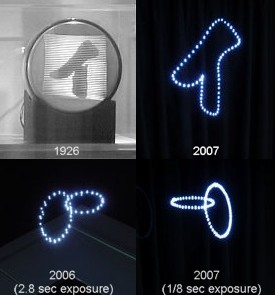 In 1926, Kenjiro Takayanagi, known as the "father of Japanese television," transmitted the image of a katakana character (?) to a TV receiver built with a cathode ray tube, signaling the birth of the world's first all-electronic television. Last week, in a symbolic gesture over 80 years later, researchers from Japan's National Institute of Advanced Industrial Science and Technology (AIST), Burton Inc. and Hamamatsu Photonics K.K. displayed the same katakana character using a 3D projector that generates moving images in mid-air.
In 1926, Kenjiro Takayanagi, known as the "father of Japanese television," transmitted the image of a katakana character (?) to a TV receiver built with a cathode ray tube, signaling the birth of the world's first all-electronic television. Last week, in a symbolic gesture over 80 years later, researchers from Japan's National Institute of Advanced Industrial Science and Technology (AIST), Burton Inc. and Hamamatsu Photonics K.K. displayed the same katakana character using a 3D projector that generates moving images in mid-air.
The 3D projector, which was first unveiled in February 2006 but has seen some recent improvements, uses focused laser beams to create flashpoint "pixels" in mid-air. The pixels are generated as the focused lasers heat the oxygen and nitrogen molecules floating in the air, causing them to spark in a phenomenon known as plasma emission. By rapidly moving these flashpoints in a controlled fashion, the projector creates a three-dimensional image that appears to float in empty space.
The projector's recent upgrades include an improved 3D scanning system that boosts laser accuracy, as well as a system of high-intensity solid-state femtosecond lasers recently developed by Hamamatsu Photonics. The new lasers, which unleash 100-billion-watt pulses (0.1-terawatt peak output) of light every 10-trillionths of a second (100 femtoseconds), improve image smoothness and boost the resolution to 1,000 pixels per second. In addition, image brightness and contrast can be controlled by regulating the number of pulses fired at each point in space.
The researchers say these improvements bring us one step closer to realizing the dream of 3DTV, but considering it took eight decades for Takayanagi's primitive 40-scan-line television to evolve into our present-day HDTV, we might have a while to wait.
[Source: AIST press release]

ben
this article is written so well it makes me want to cry ;-)
[]Wtcher
Wanna see this thing "live" or in video feed so much! (Better than Utube quality too...)
[]metalorn
well, 3 or 4 years ago I had the same idea. I can't tell if I received an image in my mind of what these scientists were working on, it just felt like inspiration. I also felt the same thing with the first spiderman movie.
cheers.
[]metalorn
Oh, and the space elevator too. I need help focusing these ideas.
[]Fractal3DArtStudio(USA)
Is this new technology, which I have drempt of so long, available to artist. If so, from whom do I buy or rent this marvel. Wish to make a video of fractal imagery, approximately 15-20 minutes long. this video would be presented to the US press in either NYC NY or Philadelphia Pa. This artist hilds a Bachelor of Science degree from Temple University's School of Communications and Theatre in Philadelphia Pa. USA. I have been working with generating original fractals for application in 3D for about the last ten years. My success is visible to anyone on my website, http://www.artwanted.com/fractal3dart. My request for more information concerning this new technology and its application in art is sincere. If available to me, I WILL use it to the best of my ability and then some! Rebecca Phillips
[]Fractal3DArt Studio fractal3d@gmail.com Looking forward to your reply.
Syed Qamar Hasan Najafi
We interested to purchase 3d floating image projector.
Kindly let us know your price as soon as possible.
Looking forward for the future business cooperation.
Regards
Qamar Hasan
[]Director
Accord Techno Trading
P.O.Box 3080, P.C. 112,
Ruwi, Muscat
Sultanate of Oman
Tel: +968-24750738
Fax: +968-24786422
Naeem Al abboodi
This My dream , this is what I see is perfact this is will open many door for this application , please can you help me to know more about this opject, I like this issue.
[]Jonathan SaBerre
When could the 3-D projector. be sold in the unithed states. I would love to open a club with the lastest tech and to open a store with stuff you offer. We have nothing down here.
[]Alex Kiselevski
Hi, i've examinated several devices, that pretended to be 3D air projectors. I understand from this article that you're the real one. Did you reach some new progress since 2007 in color image projection? Moving images?
My interest is commercial and i'm looking for such technology during 2 last years. Please contact me by mail and i will provide my tel. number for future contacts.
Thanks in advance
[]pradeep
can any one help me regarding projecting image in air throught satellite.
[]any help will be appreciated
thanks in advance
Zygmunt Kedzia
Kindly let us know your price as soon as possible.
Thanks in advance.
[]